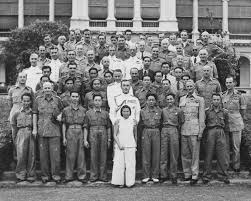Introduction
World War II was a period of unprecedented global conflict that saw countless acts of heroism, both on the battlefield and behind enemy lines. Among the many unsung heroes of the war were the members of the Special Operations Executive (SOE), a secret British organization tasked with conducting espionage, sabotage, and reconnaissance missions in Nazi-occupied Europe. Their daring exploits and unwavering courage played a crucial role in the Allied victory, yet their stories remain relatively unknown. In this article, we will delve into the fascinating world of the SOE, exploring their origins, key operations, and lasting impact on the course of history.
The Birth of the Special Operations Executive

Origins and Purpose
The SOE was established in July 1940, following the fall of France to Nazi Germany. Its creation was a direct response to the need for unconventional warfare tactics to disrupt and undermine the enemy from within. Prime Minister Winston Churchill famously instructed the SOE to “set Europe ablaze,” and the organization was tasked with coordinating resistance movements, conducting sabotage operations, and gathering intelligence.
Recruitment and Training
The SOE’s recruitment process was rigorous and highly selective. Candidates were drawn from various backgrounds, including military personnel, civilians, and even criminals. What they shared was a unique blend of courage, resourcefulness, and determination. Once recruited, agents underwent intensive training in a range of skills, including hand-to-hand combat, explosives, radio operation, and parachuting.
Key Operations of the SOE
Operation Anthropoid
One of the SOE’s most famous missions was Operation Anthropoid, the assassination of Reinhard Heydrich, the high-ranking Nazi official and architect of the Holocaust. In May 1942, two SOE-trained Czechoslovak agents, Jozef Gabčík and Jan Kubiš, ambushed Heydrich’s car in Prague. Heydrich was severely wounded and died from his injuries a week later. The mission dealt a significant blow to the Nazi regime and bolstered the morale of resistance movements across Europe.
The French Resistance and Operation Jedburgh
The SOE played a pivotal role in supporting the French Resistance, providing arms, training, and coordination. One notable operation was Operation Jedburgh, which involved deploying three-man teams of British, American, and French agents into France ahead of the D-Day invasion. These teams worked with local resistance groups to conduct sabotage operations, gather intelligence, and disrupt German supply lines.
The Norwegian Heavy Water Sabotage
Another significant SOE operation was the Norwegian heavy water sabotage, aimed at crippling Nazi Germany’s nuclear weapons program. In 1943, a team of SOE-trained Norwegian commandos successfully sabotaged the Norsk Hydro plant in Vemork, which produced heavy water—a critical component for nuclear reactors. The mission’s success delayed the Nazi atomic bomb project and demonstrated the effectiveness of targeted sabotage.
Women of the SOE
The Role of Female Agents
Women played a crucial and often overlooked role in the SOE. They served as couriers, radio operators, and field agents, carrying out dangerous missions behind enemy lines. Their ability to blend in and avoid suspicion made them invaluable assets to the organization.
Notable Female Agents
Violette Szabo: Violette Szabo was a French-British agent who conducted reconnaissance and sabotage missions in occupied France. Captured by the Gestapo, she was tortured and executed at Ravensbrück concentration camp. Szabo was posthumously awarded the George Cross for her bravery.
Nancy Wake: Known as the “White Mouse,” Nancy Wake was one of the SOE’s most decorated female agents. She led guerrilla attacks against German forces and coordinated supply drops for the resistance. Her daring exploits earned her multiple honors, including the George Medal and the Croix de Guerre.
Noor Inayat Khan: A British-Indian agent, Noor Inayat Khan served as a radio operator in occupied France. Despite the constant threat of capture, she continued to transmit vital intelligence until she was betrayed, arrested, and executed at Dachau concentration camp. Khan was posthumously awarded the George Cross.
The Challenges and Risks of SOE Operations
Operating Behind Enemy Lines
SOE agents faced immense challenges and risks while operating behind enemy lines. They had to navigate hostile territory, evade capture, and maintain contact with London through often unreliable radio transmissions. The constant threat of betrayal by informants added to the danger of their missions.
The High Cost of Bravery
Many SOE agents paid the ultimate price for their bravery. Those captured by the Gestapo faced brutal interrogations, torture, and execution. The high casualty rate among SOE operatives is a testament to their courage and dedication to the cause of freedom.
The Impact of the SOE on World War II
Disrupting Nazi Operations
The SOE’s operations significantly disrupted Nazi operations in occupied Europe. Their sabotage missions destroyed critical infrastructure, supply lines, and communication networks, hindering the German war effort and contributing to the success of Allied military campaigns.
Boosting Resistance Movements
The support provided by the SOE was instrumental in strengthening resistance movements across Europe. By supplying arms, training, and coordination, the SOE empowered local fighters to conduct guerrilla warfare and resist Nazi occupation, keeping the spirit of defiance alive.
Legacy of the SOE
Recognition and Commemoration
The contributions of the SOE have been recognized and commemorated through various memorials, museums, and awards. The courage and sacrifice of SOE agents are honored in places like the Imperial War Museum in London and the National Resistance Museum in Paris.
Influence on Modern Special Forces
The tactics and training methods developed by the SOE have had a lasting impact on modern special forces. Organizations such as the British SAS and the American Green Berets trace their roots to the pioneering work of the SOE, adopting similar techniques of unconventional warfare and covert operations.
Conclusion
The Special Operations Executive played a vital role in the Allied victory during World War II. Their daring exploits, unwavering courage, and innovative tactics disrupted Nazi operations, bolstered resistance movements, and altered the course of history. Though many of their stories remain untold, the legacy of the SOE lives on in the annals of military history and the continued fight for freedom and justice. By honoring these unsung heroes, we ensure that their sacrifices are never forgotten.
Also Read How to Cook a Perfect Steak: A Simple and Easy Guide
FAQs
1. What was the purpose of the Special Operations Executive (SOE)?
The SOE was established to conduct espionage, sabotage, and reconnaissance missions in Nazi-occupied Europe. Its primary purpose was to disrupt and undermine the enemy from within and support resistance movements.
2. Who were some notable female agents of the SOE?
Notable female agents of the SOE include Violette Szabo, Nancy Wake, and Noor Inayat Khan. These women conducted dangerous missions behind enemy lines and made significant contributions to the war effort.
3. How did the SOE support resistance movements during World War II?
The SOE supported resistance movements by providing arms, training, coordination, and intelligence. They worked closely with local fighters to conduct sabotage operations and disrupt German supply lines.
4. What were some key operations conducted by the SOE?
Key operations conducted by the SOE include Operation Anthropoid (the assassination of Reinhard Heydrich), Operation Jedburgh (supporting the French Resistance), and the Norwegian heavy water sabotage (disrupting Nazi Germany’s nuclear weapons program).
5. How has the legacy of the SOE influenced modern special forces?
The tactics and training methods developed by the SOE have influenced modern special forces such as the British SAS and the American Green Berets. These organizations have adopted similar techniques of unconventional warfare and covert operations.


